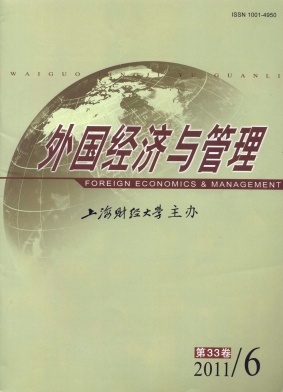国外跨界搜寻研究回顾与展望
外国经济与管理 2011 年 第 33 卷第 06 期, 页码:18 - 26
摘要
参考文献
摘要
组织跨界知识搜寻(以下简称跨界搜寻)既是创新管理、战略管理、知识管理等研究领域的交叉研究热点,又在开放式创新情境下具有重要的现实意义。本文对跨界搜寻的已有研究进行了回顾,首先系统阐述了跨界搜寻的理论基础、概念内涵和维度划分等问题,在详细探讨跨界搜寻的前因、结果、情境因素和相关变量测量等问题的基础上,构建了一个跨界搜寻的整合研究框架,最后对该领域未来研究进行了简要展望。
[1]Chesbrough,H.The era of openinnovation[J].MIT Sloan Management Review,2003,44(3):35-41.
[2]Grant,R M.Toward a knowledge-based theory of the firm[J].Strategic Management Journal,1996,17(2):109-122.
[3]Katila,R A,and Ahuja,G.Something old,something new:Alongitudinal study of search behavior and new product introduction[J].Academy of Management Journal,2002,45(6):1 183-1 194.
[4]Cyert,R M,and March,J G.Abehavioral theory of the firm[M].Englewood Ciffs,NJ:Prentice-Hall,1963.
[5]Nelson,R R,and Winter,S G.An evolutionary theory of economic change[M].Cambridge,MA:Harvard University Press,1982.
[6]Rosenkopf,L,and Nerkar,A.Beyond local search:Boundary-spanning,exploration,and i mpact in the optical disk industry[J].Strategic Management Journal,2001,22(4):287-306.
[7]Ahuja,G,and Lampert,C.Entrepreneurshipin the large corporation:Alongitudinal study of howestablished firms create break-throughinventions[J].Strategic Management Journal,2001,22(6/7):521-543.
[8]Danneels,E.Organizational antecedents of second-order competences[J].Strategic Management Journal,2008,29(5):519-543.
[9]March,J G.Exploration and exploitationin organizational learning[J].Organization Science,1991,2(1):71-87.
[10]Laursen,K,and Salter,A.Open for innovation:The role of openness in explaininginnovation performance among U K manufac-turing firms[J].Strategic Management Journal,2006,27(2):131-150.
[11]Raisch,S,and Birkinshaw,J.Organizational ambidexterity:Antecedents,outcomes,and moderators[J].Journal of Management,2008,34(3):375-409.
[12]Li,Y,Vanhaverbeke,W,and Schoenmakers,W.Exploration and exploitationininnovation:Reframingtheinterpretation[J].Cre-ativity and Innovation Management,2008,17(2):107-126.
[13]Sidhu,J S,Commandeur,H R,and Volberda,H W.The multifaceted nature of exploration and exploitation:Value of supply,de-mand,and spatial search for innovation[J].Organizational Science,2007,18(1):20-38.
[14]Ahuja,G,and Katila,R.Where do resources come from?The role of idiosyncratic situations[J].Strategic Management Journal,2004,25(8/9):887-907.
[15]Gupta,A,Smith,K G,and Shalley,C E.The interplay between exploration and exploitation[J].Academy of Management Jour-nal,2006,49(4):693-706.
[16]Levinthal,D,and March,J.Myopia of learning[J].Strategic Management Journal,1993,14(S.I.):95-112.
[17]Sidhu,S,Volberda,W,and Commandeur,R.Exploring exploration orientation andits determinants:Some empirical evidence[J].Journal of Management Studies,2004,41(6):913-932.
[18]Wu,J F,and Shanley,M T.Knowledge stock,exploration,and innovation:Research on the United States electromedical deviceindustry[J].Journal of Business Research,2009,62(5):474-483.
[19]Koka,R,and Prescott,E.Designing alliance networks:Theinfluence of network position,environmental change,and strategy onfirmper-formance[J].Strategic Management Journal,2008,29(6):639-661.
[20]Granovetter,MS.Economic action and social structure:The problem of embedded[J].American Journal of Sociology,1985,91(3):481-510.
[2]Grant,R M.Toward a knowledge-based theory of the firm[J].Strategic Management Journal,1996,17(2):109-122.
[3]Katila,R A,and Ahuja,G.Something old,something new:Alongitudinal study of search behavior and new product introduction[J].Academy of Management Journal,2002,45(6):1 183-1 194.
[4]Cyert,R M,and March,J G.Abehavioral theory of the firm[M].Englewood Ciffs,NJ:Prentice-Hall,1963.
[5]Nelson,R R,and Winter,S G.An evolutionary theory of economic change[M].Cambridge,MA:Harvard University Press,1982.
[6]Rosenkopf,L,and Nerkar,A.Beyond local search:Boundary-spanning,exploration,and i mpact in the optical disk industry[J].Strategic Management Journal,2001,22(4):287-306.
[7]Ahuja,G,and Lampert,C.Entrepreneurshipin the large corporation:Alongitudinal study of howestablished firms create break-throughinventions[J].Strategic Management Journal,2001,22(6/7):521-543.
[8]Danneels,E.Organizational antecedents of second-order competences[J].Strategic Management Journal,2008,29(5):519-543.
[9]March,J G.Exploration and exploitationin organizational learning[J].Organization Science,1991,2(1):71-87.
[10]Laursen,K,and Salter,A.Open for innovation:The role of openness in explaininginnovation performance among U K manufac-turing firms[J].Strategic Management Journal,2006,27(2):131-150.
[11]Raisch,S,and Birkinshaw,J.Organizational ambidexterity:Antecedents,outcomes,and moderators[J].Journal of Management,2008,34(3):375-409.
[12]Li,Y,Vanhaverbeke,W,and Schoenmakers,W.Exploration and exploitationininnovation:Reframingtheinterpretation[J].Cre-ativity and Innovation Management,2008,17(2):107-126.
[13]Sidhu,J S,Commandeur,H R,and Volberda,H W.The multifaceted nature of exploration and exploitation:Value of supply,de-mand,and spatial search for innovation[J].Organizational Science,2007,18(1):20-38.
[14]Ahuja,G,and Katila,R.Where do resources come from?The role of idiosyncratic situations[J].Strategic Management Journal,2004,25(8/9):887-907.
[15]Gupta,A,Smith,K G,and Shalley,C E.The interplay between exploration and exploitation[J].Academy of Management Jour-nal,2006,49(4):693-706.
[16]Levinthal,D,and March,J.Myopia of learning[J].Strategic Management Journal,1993,14(S.I.):95-112.
[17]Sidhu,S,Volberda,W,and Commandeur,R.Exploring exploration orientation andits determinants:Some empirical evidence[J].Journal of Management Studies,2004,41(6):913-932.
[18]Wu,J F,and Shanley,M T.Knowledge stock,exploration,and innovation:Research on the United States electromedical deviceindustry[J].Journal of Business Research,2009,62(5):474-483.
[19]Koka,R,and Prescott,E.Designing alliance networks:Theinfluence of network position,environmental change,and strategy onfirmper-formance[J].Strategic Management Journal,2008,29(6):639-661.
[20]Granovetter,MS.Economic action and social structure:The problem of embedded[J].American Journal of Sociology,1985,91(3):481-510.
引用本文
熊伟, 奉小斌, 陈丽琼. 国外跨界搜寻研究回顾与展望[J]. 外国经济与管理, 2011, 33(6): 18–26.
导出参考文献,格式为:





 6412
6412  768
768

